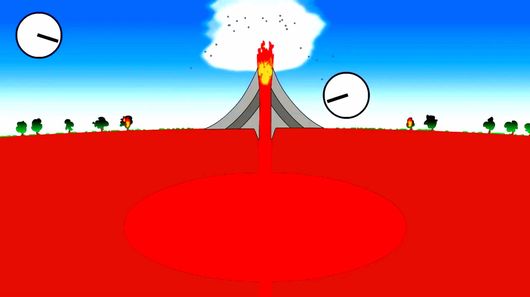If you've ever been to Yellowstone National Park in Wyoming, you may have been aware of two things; its magnificent grandeur, and the fact that it's an active supervolcano that, if it ever erupted again, would be worst event to hit the Earth since the dinosaur-killing asteroid. To help keep an eye out for this and similar events, a team at the University of Zurich have developed a means of monitoring volcanic events using atomic clocks.
Atomic clocks are the most accurate timepieces ever constructed. Using the vibration of cesium atoms instead of a swinging pendulum, they attain a level of precision so fine that they lose less than one second in 10 billion years. This makes them extremely useful for all sorts of applications, such as astronomy, physics, computing and navigation, but geology hasn't got much of a look in. That is, until a team led by the Institute of Physics from the University of Zurich came up with a way to use these clocks to monitor volcanic activity.
The technique relies on Einstein's theory of general relativity, which, putting it simply, says that time flows at different rates in different circumstances. The most famous example of this is a spaceship travelling away from Earth at the speed of light. Aboard is one pair of a set of twins while the other stays home. When the ship returns, the earthbound twin has aged 20 years, but the other has only aged a few months because the tremendous velocity has slowed down time.
The same effect can be produced by gravity. Someone standing on the surface of the Earth will be closer to the planet's mass and age infinitesimally less than someone on the International Space Station (ISS) because time slows down for them. This is why the station is useful for relativity experiments and why it's a common joke that astronauts in orbit deserve extra pay because more time has passed for them than for their counterparts back on Earth.
This relativistic effect is what the Zurich team is using to study volcanoes. When a volcano is approaching an eruption, chambers beneath it fill with molten magma. This increases the local mass, and therefore the local gravity. An atomic clock positioned in the vicinity of the volcano will detect this change because the increase in mass will cause time to slow down. The rate of this slowing, and hence the mass build up, can be measured by comparing the clock to a reference clock some distance away.
The Zurich team says that this technique is already in use, but it depends on GPS satellite signals. However, these rely on much less precise clocks, so the measurements can take months, while an atomic clock can do the same job in a matter of hours.
The team's hope is that the technique could be running in a few years by linking a network of atomic clocks using fiber optic cables over the internet as a new early warning system against eruptions. In addition, such a network could also be used to study tides that not only influence the movements of the sea, but also cause the Earth's mass to shift by up to 50 cm (19.6 in) twice a day.
"We need this additional tool to monitor magma movement under volcanoes such as the Yellowstone supervolcano, which is overdue for an explosion that would alter life on Earth as we known it," says team leader Ruxandra Bondarescu.
The team's results were published in the Geophysical Journal International.
Source: University of Zurichcopyright © Gizmag 2003 - 2015
http://www.gizmag.com/atomic-clocks-volcano-monitoring/38251
